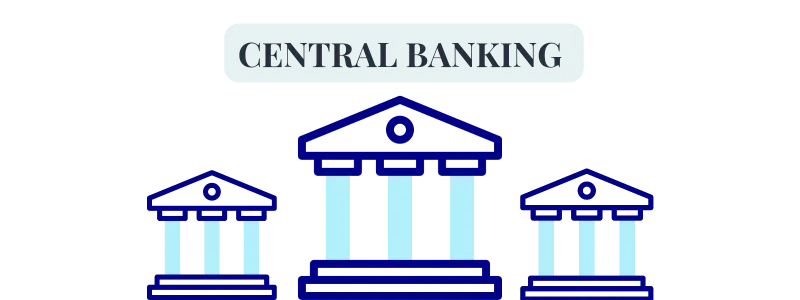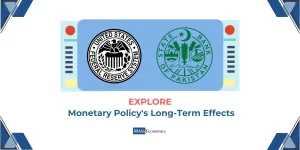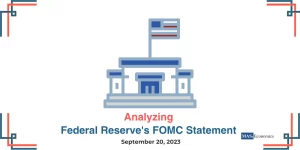What is Central Banking?
Central banking is the system of managing a country’s money supply and regulating financial institutions in order to ensure economic stability. The central bank controls interest rates and the amount of currency available in circulation, often through various economic policies and interventions.
While central banks have been around for centuries, their development over time was shaped by key historical events such as wars, national crises, and technological advancements. Many of these factors led to rapid changes in how central banks operated or even influenced whether they were established in certain countries.
History of Central Banks
The origins of central banks can be traced back to Europe during the 17th century when merchants began issuing paper notes alongside gold and silver coins to supplement their trading activities. As more and more people began using these notes, it soon became apparent that a system was needed to regulate their circulation and ensure that they were backed by real money.
In 1668, the first central bank established was the Riksbankof Sweden. Then Bank of England was established by King William in 1694 to lend to the British government to finance its war against France. This institution was critical in funding the country’s military efforts during the Seven Years’ War, which helped solidify its position as an influential European country.
Other European countries eventually followed suit, establishing similar central banking systems during this time period. The Bank of France was established in 1800, and the Netherland Bank in 1814.
In 1791, the First Bank of the United States was established to refinance the war-related debt accumulated by different states; for the same purpose, and the second Bank of the U.S was established in 1816.
However, even though these institutions were established with good intentions, many devolved into corrupt entities that manipulated monetary policy for their gain. For example, starting around 1815, many of these central banks began financing the governments of their respective countries in order to fund military conflicts.
Functions of Modern Central Banks
Technological advancements throughout the 19th and 20th centuries also played an essential role in transforming the modern central banking system. To achieve their objectives, these banks perform primary and secondary functions, including:
Primary Functions
- issue and manage the national currency
- Formulate and implement monetary policy.
- Regulate and supervise the financial system.
- Foster a safe and efficient payment system.
- Lender of last resort
Secondary Functions
- Public debt management
- Foreign exchange management
- advisor and banker to the government
- non-traditional development role
Today, almost every country has its own central bank, and they continue to play an essential role in regulating financial markets and protecting the stability of their respective countries’ economies. Despite some recent setbacks (the global financial crisis), the central banking system is widely regarded as among the world’s most important economic institutions today.
The Federal Reserve System of the United States of America
The Fed is the U.S. central bank. An act of Congress was created in 1913; Its tasks include providing financial services to the U.S. government, regulating member banks, and executing monetary policy.
The Federal Reserve System comprises 12 regional Federal Reserve Banks, each serving a particular country’s geographic region. The Board of Governors, located in Washington, D.C., is the Fed’s policymaking body.
The first bank chartered by the U.S. Congress was the First Bank of the United States, which opened for business in 1791. That bank’s charter expired 20 years later, and Congress chartered the Second Bank of the United States in 1816. However, that second bank’s charter was not renewed in 1836, and closed its doors in 1841.
Federal Reserve Bank
The Panic of 1907 led a group of bankers to call for establishing a central bank that could provide liquidity (cash) to the banking system during times of panic or financial crisis. In 1910, a group of bankers met secretly on Jekyll Island, Georgia, to discuss this idea further. As a result of those discussions, Congress established the Federal Reserve System in 1913 by enacting the Federal Reserve Act.
The Federal Reserve Bank is responsible for several vital functions, including:
Regulating member banks: The Fed is responsible for supervising and examining state-chartered banks, including members of the Federal Reserve System. These banks must follow specific regulations, such as maintaining a certain percentage of their assets in reserve (cash on hand that can be used to meet customer withdrawals).
Conducting monetary policy: The Fed controls the amount of money and credit in the economy with monetary policy. This changes interest rates (Fund Rate) and economic activity.
Providing financial services to the government of the United States: The Fed provides banking services to the U.S. Treasury, including processing tax payments and issuing debt securities.
The Federal Reserve System, created in 1913 under the Federal Reserve Act, comprises a central bank, 12 regional banks, and a network of private banks. The central bank, known as the Federal Reserve Board (or simply the Fed), is responsible for setting monetary policy and overseeing the banking system. The 12 regional banks supervise member banks and conduct economic research. Finally, the network of private banks provides capital to the banking system and helps to clear checks and process electronic payments.
The Federal Reserve has a dual mandate to promote employment and stable prices. In order to achieve these goals, the Fed uses three primary tools: The discount rate, open market operations, and reserve requirements.
The Federal Open Market Committee (FOMC) comprises five of the 12 regional bank presidents and seven members of the Board of Governors, who decides how the Fed will handle money. The FOMC gets together eight times a year to talk about the economy, review monetary policy strategy, and make decisions about it.
What is Monetary Policy?
Monetary policy is the process by which central banks, for instant, the Federal Reserve in the United States, control the money supply in an economy. This process can involve several actions, including altering interest rates (Fed’s Fund Rate) and controlling the number of money banks are required to keep on reserve with their central bank. By carefully managing these factors, central banks hope to achieve specific economic goals like price stability and full employment by fully utilizing productive resources.
There are several reasons why monetary policy is so crucial for modern economies. For one thing, controlling the level of money circulating in an economy can significantly impact overall prices.
Maintaining the value of money and promoting the confidence of the public to hold domestic currency
When excessive money is available in an economy, demand increases, and prices rise. Similarly, demand decreases, and prices fall when less money is available. Therefore, modern central banks will often use monetary policy to try and achieve a certain level of inflation or price stability within an economy.
Another important function of monetary policy is controlling borrowing costs for consumers and businesses. Central banks can encourage or discourage borrowing in different parts of the economy by altering interest rates. Low-interest rates make it easy for consumers and businesses to borrow money, which can stimulate economic activity by increasing consumer spending and business investment. Conversely, high-interest rates make it more expensive for borrowers to take on new debt, which curbs economic activity. As such, central banks frequently use monetary policy to help adjust economic cycles and promote more robust long-term economic growth.
Overall, monetary policy is a crucial tool for central banks as they work to achieve specific economic objectives and promote strong and stable growth. By carefully adjusting interest rates, controlling the money supply, and managing exchange rates, central banks can play an essential role in shaping both short-term conditions and long-term economic growth. While there is always a degree of uncertainty involved in managing monetary policy, this process can be an effective way for central banks to promote the prosperity of their countries and regions.
What are the Objectives of Monetary Policy?
Monetary policy has a dual mandate of ensuring price stability and financial stability. This broad mandate could be interpreted in several ways, but the focus is on keeping inflation within target and the smooth functioning of the financial market.
The objectives of central banks vary from country to country, but they typically include maintaining price stability, promoting economic growth, and providing financial stability.
Central banks use monetary policy to help address issues such as high unemployment or inflation. For example, if the unemployment rate is too high, monetary policymakers may seek to boost aggregate demand by lowering interest rates or increasing the money supply. This should encourage businesses and consumers to spend more money, leading to increased hiring and growth in the overall economy.
In contrast, if the economy is experiencing high inflation, central banks may use monetary policy to raise interest rates or reduce the money supply to slow down the economy and lower inflation. Using tools like these, policymakers can seek to achieve a range of specific goals related to employment, price stability, and overall financial stability.
Tools of Monetary Policy
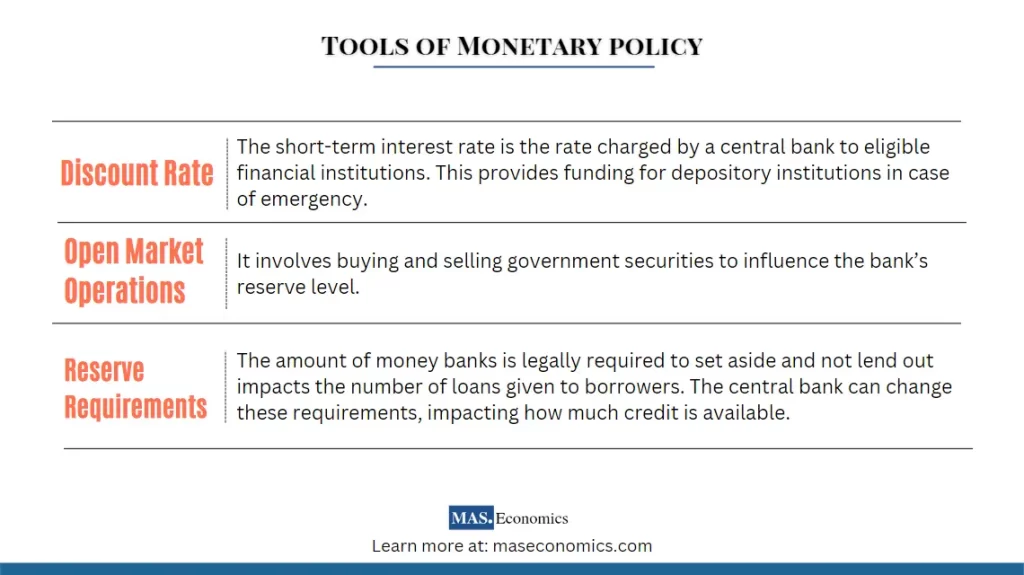
There are traditional and non-traditional monetary policy tools at the disposal of many central banks.
Once again, in the example of the central bank of the U.S, the Federal Reserve, in normal times, it uses three traditional tools to conduct monetary policy: reserve requirements, the discount rate, and open market operations.
The discount rate is the short-term interest rate a Federal Reserve Bank charges eligible financial institutions. It is set by Reserve Bank boards, with the Board of Governors’ approval. The discount rate provides depository institutions with backup funding.
Open market operations involve buying and selling government securities to influence the bank’s reserve level. Open market operations were formerly the Fed’s primary monetary policy instrument.
Reserve requirements refer to the percentage of deposits banks hold in reserve and cannot lend out. By changing these requirements, the Fed can influence the number of credit banks extending to borrowers.
However, when faced with a severe financial crisis, such as 2007-2008, the Fed can also turn to non-traditional tools such as asset purchases and lending facilities. In response to the COVID-19 pandemic, the Fed has once again employed its full range of tools, both traditional and non-traditional. These tools are designed to ensure that credit continues to flow to households and businesses during this difficult time.
Overall, governments use many different monetary policy tools to manage their economies and achieve specific goals. However, these tools must be used judiciously as they can have unintended consequences if deployed incorrectly.
Types of Monetary Policy
Monetary policy can be divided into two main categories: expansionary and contractionary policy.
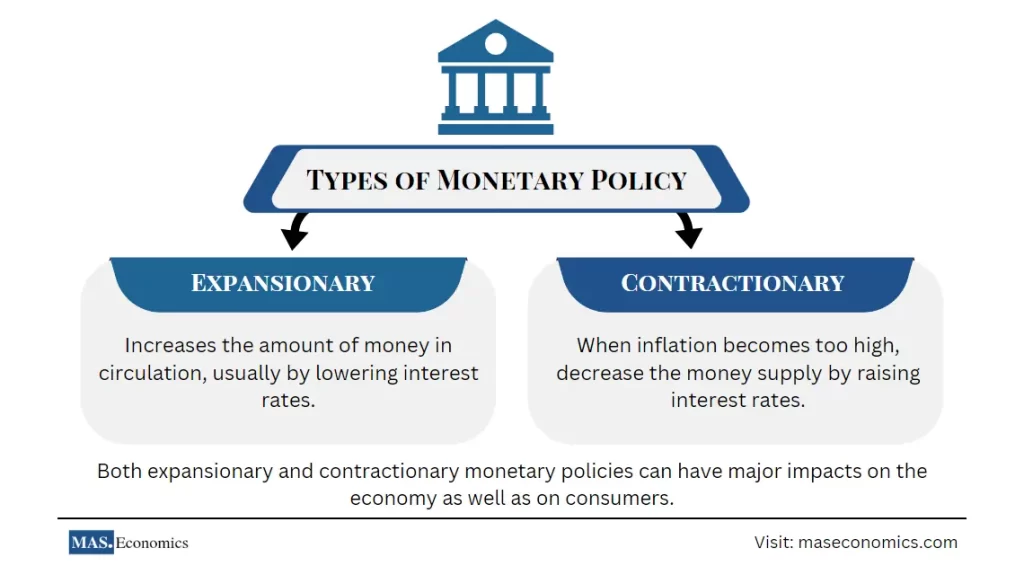
Expansionary Monetary Policy
Expansionary monetary policy increases the amount of money in circulation, usually by lowering interest rates. This monetary policy typically leads to increased consumer spending and economic growth. Some standard tools used by central banks that implement an expansionary monetary policy are open market operations, discount rate cuts, changes in reserve requirements, and quantitative easing (QE).
Contractionary Monetary Policy
Contractionary monetary policy is used to decrease the money supply by raising interest rates or decreasing the number of money banks can lend to consumers. This type of monetary policy is usually employed when inflation becomes too high or when there are concerns about a recession or financial crisis. Standard tools used by central banks to implement a contractionary monetary policy include open market operations, increases in the discount rate, changes in reserve requirements, and increasing the required amount of reserves that banks must hold.
Both expansionary and contractionary monetary policies can have major impacts on the economy as well as on consumers. For example, lowering interest rates encourages consumers to spend more money and boosts economic growth. However, borrowing becomes cheaper for businesses and consumers, which may lead to higher inflation. On the other hand, raising interest rates usually discourages consumer spending but helps prevent inflation from getting out of control or causing financial problems like bankruptcy.
Additionally, increasing the money supply via quantitative easing (QE) or lowering reserve requirements can increase inflation, but this is a temporary effect.
In the end, understanding the different types of monetary policy is vital for consumers and businesses alike to understand how changes in interest rates or money supply can impact their finances. It also helps explain why central banks use particular tools to achieve specific goals and how those actions may impact economic growth, inflation, unemployment levels, and other factors.
Inflation Targeting
Inflation targeting was introduced in 1997 by Alan Greenspan, who said that our best hope for avoiding deflationary pressures lies in maintaining low and stable inflation. He believed the Federal Reserve could achieve this without tight fiscal policies because he thought the Fed had more tools than raising/lowering interest rates (Greenspan, 1997). It allows policymakers to focus on achieving a particular objective rather than managing multiple objectives simultaneously. The central bank can use monetary policy to offset shocks or events that would otherwise destabilize the economy. Policymakers may concentrate solely on one of these goals, such as unemployment or inflation.
Difference between Monetary policy and Fiscal Policy
Fiscal and monetary policy are two essential tools that governments use to influence the economy. While they may seem similar, the two policies have some key differences.
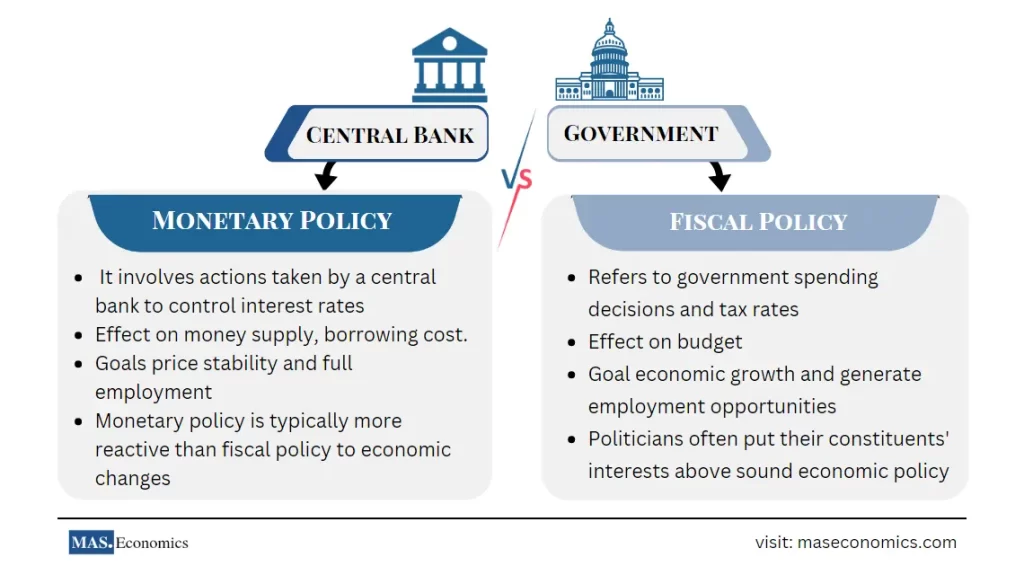
One significant difference between fiscal and monetary policy is that fiscal policy refers to government spending decisions and tax rates. In contrast, monetary policy involves actions taken by a central bank to control interest rates and money in circulation.
Another critical difference between these two types of policies is that monetary policy tends to be more reactive than fiscal policy. For example, suppose there is an economic downturn or financial crisis. In that case, a central bank will usually respond with changes in interest rates or other measures to influence lending and investment behavior within the private sector.
In comparison, fiscal policy is usually less reactive and takes a more long-term view of the economy. Governments often use fiscal policy to achieve specific economic goals, such as reducing unemployment or promoting economic growth.
Overall, while both monetary and fiscal policies can have an impact on the overall economy, they are typically used in different ways and serve different purposes. Understanding these differences is essential for anyone who wants to understand how governments influence the economy.
Modern Monetary Theories
Modern monetary theory, or MMT for short, is a body of economic thinking that focuses on money’s role in our economy. At its core, MMT suggests that specific government budget policies and fiscal actions can be taken to ensure strong economic growth and full employment.
One fundamental concept of MMT is the belief that a sovereign nation’s currency operates under different rules than other forms of money. At the same time, individuals and private companies are constrained by financial limits when they borrow money. Countries like the United States do not face similar constraints when doing so through their central bank – meaning they can always print more money to cover their debts if needed. This difference in how sovereign currencies work compared to others has led many economists to view modern monetary theories as a reinvention of existing macroeconomic theories.
However, while some economists may be wary of modern monetary theories, it has gained significant traction in the political and financial realms over the past decade. Many prominent politicians, including former Democratic presidential candidate Bernie Sanders, have voiced their support for at least some aspects of this theory. Moreover, even central banks like the Federal Reserve Bank and European Central Bank (ECB) have begun to take notice of their influence, leading them to adapt their policies accordingly.
Whether you think that modern monetary theories are helpful or harmful to our economy remains a debate among economists and policymakers alike. However, regardless, the principles behind this theory will determine the future of our economy and financial system.
Who Controls Monetary Policy?
Who controls monetary policy varies from country to country. Central banks in most developed economies, such as those in North America and Europe, are typically responsible for making monetary policy decisions. These institutions are given a great deal of independence from political interference and control regarding their monetary policy decisions. They (Independent Central Bank) are also often granted special legal privileges that allow them more power than other public institutions in influencing economic outcomes.
However, the central bank is more closely linked to political process in some countries, such as China, Pakistan, and India. This can result in the monetary policy being shaped by the priorities of democratically elected officials, with less regard for economic outcomes. In these cases, it can be difficult for central banks to exercise their independence and make decisions that are in the economy’s best interest as a whole.
As a result, there is often debate about who should control monetary policy: politicians or independent experts. Some argue that central bankers have a better understanding of how changes to monetary policy will affect different segments of the economy and, therefore, should be given greater autonomy over their decisions. Others believe that politicians need to consider public opinion when making decisions about monetary policy and that they should be given as much input as possible when making economic decisions.
Reference:
Ugolini, S. (2017). The evolution of central banking: theory and history. London: Palgrave Macmillan.
Moenjak, T. (2014). Central banking: theory and practice in sustaining monetary and financial stability. John Wiley & Sons.
Singleton, J. (2010). Central banking in the twentieth century. Cambridge University Press.

